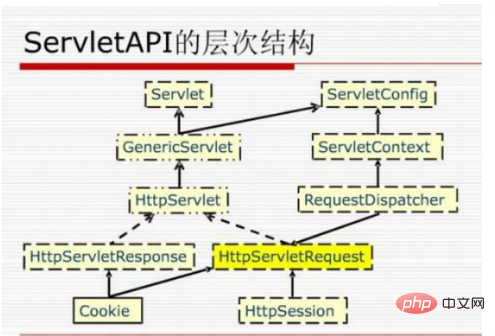Detailed explanation of the difference between jsp and servlet

Detailed explanation of the difference between jsp and servlet
The differences between jsp and servlet are as follows:
Jsp is a simplification of Servlet. Using Jsp only needs to complete the content that the programmer needs to output to the client. How to embed the Java script in Jsp into a class is completed by the Jsp container.
Recommended: "Java Learning"
1. jsp becomes a Servlet after compilation.
2. JSP is better at page display, and servlet is better at logic control.
3. There are no built-in objects in Servlet. The built-in objects in Jsp must be obtained through the HttpServletResponse object and the HttpServlet object.
4. Servlet is a complete Java class. The Service method of this class is used to generate a response to the client.

Extended information:
The difference between Servlet and JSP:
1. The application logic of Servlet is in the Java file, and Completely separated from the HTML in the presentation layer.
2. In the case of JSP, Java and HTML can be combined into a file with a .jsp extension.
3. JSP focuses on views, and Servlet is mainly used for control logic.
4. Servlet is more like a Controller, used for control.
For more programming related content, please pay attention to the Programming Tutorial column on the php Chinese website!
The above is the detailed content of Detailed explanation of the difference between jsp and servlet. For more information, please follow other related articles on the PHP Chinese website!

Hot AI Tools

Undresser.AI Undress
AI-powered app for creating realistic nude photos

AI Clothes Remover
Online AI tool for removing clothes from photos.

Undress AI Tool
Undress images for free

Clothoff.io
AI clothes remover

AI Hentai Generator
Generate AI Hentai for free.

Hot Article

Hot Tools

Notepad++7.3.1
Easy-to-use and free code editor

SublimeText3 Chinese version
Chinese version, very easy to use

Zend Studio 13.0.1
Powerful PHP integrated development environment

Dreamweaver CS6
Visual web development tools

SublimeText3 Mac version
God-level code editing software (SublimeText3)

Hot Topics
 1376
1376
 52
52
 Is jsp front-end or back-end?
Jan 28, 2023 pm 06:23 PM
Is jsp front-end or back-end?
Jan 28, 2023 pm 06:23 PM
jsp belongs to the backend. The essence of jsp is a servlet, and servlet is a server-side java application, so jsp is a back-end technology. JSP is deployed on the web server and can respond to requests sent by the client and dynamically generate web pages of HTML, XML or other format documents based on the request content, and then return them to the requester. JSP technology uses Java as a scripting language to provide services for user HTTP requests, and can handle complex business requirements together with other Java programs on the server.
 The servlet life cycle is divided into several stages
Feb 23, 2023 pm 01:46 PM
The servlet life cycle is divided into several stages
Feb 23, 2023 pm 01:46 PM
The Servlet life cycle refers to the entire process from creation to destruction of a servlet, which can be divided into three stages: 1. Initialization stage, calling the init() method to initialize the Servlet; 2. Running stage (processing requests), the container will Request to create a ServletRequest object representing an HTTP request and a ServletResponse object representing an HTTP response, and then pass them as parameters to the service() method of the Servlet; 3. Destruction phase.
 What is a servlet
Jan 28, 2023 am 09:51 AM
What is a servlet
Jan 28, 2023 am 09:51 AM
The full name of Servlet is "Java Servlet", which means small service program or service connector in Chinese. It is a program running on a Web server or application server. It serves as a request from a Web browser or other HTTP client and a database on the HTTP server or The middle layer between applications. Servlet has the characteristics of being independent of platform and protocol. Its main function is to browse and generate data interactively and generate dynamic Web content.
 What are the application scenarios of Java Servlet?
Apr 17, 2024 am 08:21 AM
What are the application scenarios of Java Servlet?
Apr 17, 2024 am 08:21 AM
JavaServlet can be used for: 1. Dynamic content generation; 2. Data access and processing; 3. Form processing; 4. File upload; 5. Session management; 6. Filter. Example: Create a FormSubmitServlet to handle form submission, taking name and email as parameters, and redirecting to success.jsp.
 How to integrate JSP in SpringBoot project
May 12, 2023 pm 07:40 PM
How to integrate JSP in SpringBoot project
May 12, 2023 pm 07:40 PM
After the new springboot project is created, the directory is as follows: Step 1: Add the jar package code required to configure jsp to the project's pom file: org.apache.tomcat.embedtomcat-embed-jasperprovided Step 2: Create a new directory webapp under the main path , create a new path WEB-INF under webapp, create a new path jsp under WEB-INF, and place the jsp file we want to use under this path. Step 3: Configure the access path and suffix code of the jsp file in the main configuration file: spring .mvc.view.prefix=/WEB-INF/jsp/sp
 What is the difference between jsp and html
Jan 09, 2024 am 10:46 AM
What is the difference between jsp and html
Jan 09, 2024 am 10:46 AM
The difference between jsp and html: 1. Operating mechanism; 2. Purpose; 3. Relationship with Java; 4. Function; 5. Relationship with back-end; 6. Speed; 7. Maintainability and scalability; 8. Learning and use Difficulty; 9. File suffixes and identification tools; 10. Community and support; 11. Security. Detailed introduction: 1. Operating mechanism. HTML is a markup language, mainly used to describe and define the content of web pages. It runs on the client and is interpreted and executed by the browser. JSP is a dynamic web page technology that runs on the server side, etc. wait.
 How to implement jsp paging function
Mar 04, 2024 pm 04:40 PM
How to implement jsp paging function
Mar 04, 2024 pm 04:40 PM
Implementation steps: 1. Introduce the JSTL tag library into the JSP page; 2. Obtain data from the database; 3. Paging the data; 4. Display the paging navigation bar in the page; 5. Display the number according to the current page number and each page. , just get the corresponding data from the paging data and display it on the page.
 How does Java Servlet implement distributed session management?
Apr 16, 2024 pm 02:48 PM
How does Java Servlet implement distributed session management?
Apr 16, 2024 pm 02:48 PM
There are two ways to implement distributed session management in JavaServlet: 1. Session replication: Copy session data to each server. 2. Session distribution: Use a centralized storage service to store session data and access it from multiple servers. The specific implementation methods are: session replication configures true in the web. session data.




